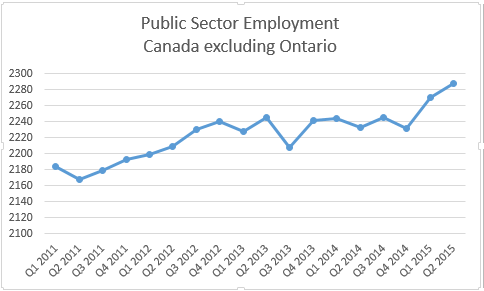The suggestion that Ontario has a deficit because its public sector is too large does not bear scrutiny. Consider the following.
Public sector employment has fallen in the last three quarters in Ontario. Since 2011, public sector employment has been pretty flat, with employment up less than 4 tenths of one percent in the first half of 2015 compared with the first half of 2011.
This contrasts with public sector employment outside of Ontario which has gone up pretty consistently and is now 4.7% higher than it was in the first half of 2011.
Private sector employment has also gone up consistently over that period. In Ontario, it has increased 4.3% since the first half of 2011, while in Canada as a whole it has increased 4.9%.

As a result, public sector employment in Ontario is now shrinking as a percentage of the private sector workforce. In contrast, in the rest of Canada, it is increasing. Moreover, public sector employment is much higher in the rest of Canada than in Ontario. Indeed as a percentage of private sector employment it is now almost 5 percentage points higher in the rest of Canada than it is in Ontario.

Further, as a percentage of the population, public sector workers in Ontario fall well below the corresponding percentage for the rest of Canada.
Indeed, private sector workers are a larger percentage of the population in Ontario than the rest of Canada.
If Ontario was like the rest of Canada, we would have 117,000 more public employees and 121,000 fewer private sector workers. This despite having the capital of Canada in Ontario.
As noted last July, low revenue, not bloated public spending, drives the deficit in Ontario.
 Health care and social assistance workers: There has been a larger increase in “health care and social assistance employees” than for either public sector workers or private sector workers over the last five years according to Labour Force Survey data from Statistics Canada.
Health care and social assistance workers: There has been a larger increase in “health care and social assistance employees” than for either public sector workers or private sector workers over the last five years according to Labour Force Survey data from Statistics Canada.
In Ontario, the 11% increase from 2010 to 2015 is about twice the rate of increase of public sector and private sector workers (which increased 6.1% and 5.1% respectively over that period). Given an aging population and increasing demand for health care utilization, rapid increases may well continue -- but whether this drives up private sector health care workers or public sector health care workers is another matter. More on this in an upcoming post.
Notably, Ontario has both a lower level of health care and social assistance workers than the rest of Canada (relative to population), and the rate of increase in the number of health care and social assistance workers has been almost 1/3 faster in the rest of Canada than in Ontario.

More detail on the nature of the changes to the health care workforce will come in a future post.
Data Sources: Statistics Canada CANSIM 282-0089 and CANSIM 282-0088
Public sector employment has fallen in the last three quarters in Ontario. Since 2011, public sector employment has been pretty flat, with employment up less than 4 tenths of one percent in the first half of 2015 compared with the first half of 2011.
This contrasts with public sector employment outside of Ontario which has gone up pretty consistently and is now 4.7% higher than it was in the first half of 2011.
Private sector employment has also gone up consistently over that period. In Ontario, it has increased 4.3% since the first half of 2011, while in Canada as a whole it has increased 4.9%.

As a result, public sector employment in Ontario is now shrinking as a percentage of the private sector workforce. In contrast, in the rest of Canada, it is increasing. Moreover, public sector employment is much higher in the rest of Canada than in Ontario. Indeed as a percentage of private sector employment it is now almost 5 percentage points higher in the rest of Canada than it is in Ontario.

Further, as a percentage of the population, public sector workers in Ontario fall well below the corresponding percentage for the rest of Canada.
As noted last July, low revenue, not bloated public spending, drives the deficit in Ontario.
 Health care and social assistance workers: There has been a larger increase in “health care and social assistance employees” than for either public sector workers or private sector workers over the last five years according to Labour Force Survey data from Statistics Canada.
Health care and social assistance workers: There has been a larger increase in “health care and social assistance employees” than for either public sector workers or private sector workers over the last five years according to Labour Force Survey data from Statistics Canada. In Ontario, the 11% increase from 2010 to 2015 is about twice the rate of increase of public sector and private sector workers (which increased 6.1% and 5.1% respectively over that period). Given an aging population and increasing demand for health care utilization, rapid increases may well continue -- but whether this drives up private sector health care workers or public sector health care workers is another matter. More on this in an upcoming post.
Notably, Ontario has both a lower level of health care and social assistance workers than the rest of Canada (relative to population), and the rate of increase in the number of health care and social assistance workers has been almost 1/3 faster in the rest of Canada than in Ontario.

More detail on the nature of the changes to the health care workforce will come in a future post.
Data Sources: Statistics Canada CANSIM 282-0089 and CANSIM 282-0088








Comments
Post a Comment